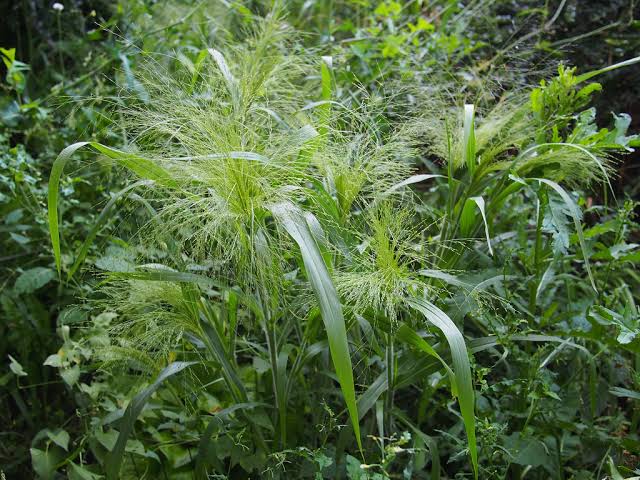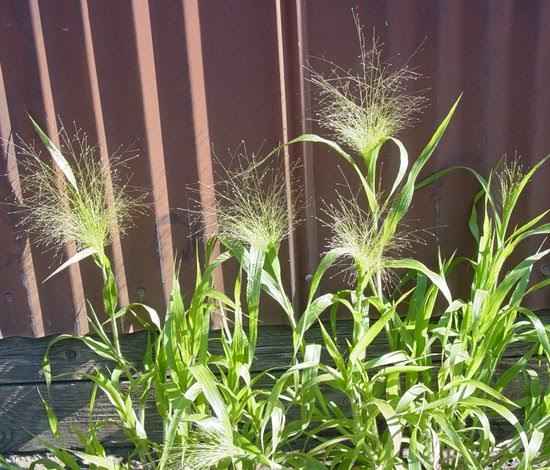Witchgrass (Panicum capillare) is a fascinating plant that can be found in various habitats across North America. This resilient grass is known for its slender stems and feathery seed heads, which give it a distinctive appearance. As an annual grass, Witchgrass completes its life cycle within a year, germinating, growing, flowering, and producing seeds in a relatively short span.
One notable characteristic of Witchgrass is its adaptability to different environments. You can encounter this grass in open fields, meadows, disturbed areas, and even along roadsides. Its ability to thrive in diverse conditions showcases the resilience of nature’s creations.
The slender stems of Witchgrass can reach varying heights, adding a touch of delicacy to the landscape. During the flowering season, the plant produces intricate panicles with tiny flowers, creating a visually appealing display. The airy quality of the seed heads adds an ethereal charm to the surroundings.
Panicum capillare plays a role in the ecosystem by providing habitat and sustenance for various organisms. Insects, such as butterflies and bees, are attracted to its flowers, contributing to pollination processes. Additionally, the seeds serve as a food source for birds and small mammals, highlighting the interconnectedness of species in the natural world.
Despite its ecological significance, Witchgrass is sometimes considered a weed in agricultural settings. Its adaptability and ability to spread quickly can lead to challenges for crop management. Farmers employ various strategies to control its growth and maintain a balance in the ecosystem.
Understanding the life cycle and ecological role of Witchgrass contributes to a broader appreciation for the intricacies of the natural world. As we observe this unassuming plant, we gain insights into the dynamic relationships between organisms and their environment. Witchgrass serves as a reminder of the beauty and complexity that exist in even the seemingly ordinary elements of our surroundings.
Read Also: The Appearance and Features of Tilapia Fish
How To Grow Witchgrass (Panicum capillare)

Growing Witchgrass (Panicum capillare) can be a straightforward and rewarding process. Follow these steps to cultivate this resilient grass:
1. Choose the Right Location: Select a suitable location with well-drained soil and exposure to sunlight. Witchgrass is adaptable but thrives in areas with ample sunlight.
2. Prepare the Soil: Ensure the soil is well-prepared by loosening it and removing any debris. Although Witchgrass can tolerate various soil types, a moderately fertile soil can promote better growth.
3. Seed Sowing: Scatter the Witchgrass seeds evenly over the prepared soil. Press them lightly into the ground, ensuring good seed-to-soil contact.
4. Watering: Water the area thoroughly after sowing the seeds. Keep the soil consistently moist until the grass establishes itself. Avoid waterlogging, as Witchgrass prefers well-drained conditions.
5. Germination Period: Be patient during the germination period, which typically takes a couple of weeks. Maintain regular watering to support seedling growth.
6. Thinning (Optional): If the plants appear too crowded as they grow, consider thinning them to allow for better air circulation and prevent competition for resources.
7. Maintenance: Witchgrass is relatively low-maintenance. Once established, it can tolerate drought conditions. However, occasional watering during dry spells can promote healthier growth.
8. Harvesting Seeds (Optional): If you’re interested in collecting seeds for future planting, allow the grass to reach maturity and produce seed heads. Harvest the seeds once they have ripened.
9. Control Spread (If Necessary): In certain settings, Witchgrass can be considered invasive. Keep an eye on its spread and take measures if it starts encroaching on other plants or areas.
10. Appreciate its Beauty: Take a moment to appreciate the unique appearance of Witchgrass as it matures. The feathery seed heads add a touch of elegance to the landscape.
By following these simple steps, you can successfully grow Witchgrass and enjoy its unique characteristics in your garden or landscape.
How To Care For Witchgrass (Panicum capillare)
Caring for Witchgrass (Panicum capillare) involves a few essential practices to ensure its well-being:
1. Watering: Maintain consistent soil moisture, especially during the growing season. While Witchgrass is adaptable to dry conditions, regular watering supports healthier growth.
2. Soil Quality: Ensure well-drained soil to prevent waterlogging. Witchgrass can tolerate various soil types, but a moderately fertile soil enhances its overall health.
3. Sunlight Exposure: Plant Witchgrass in an area that receives ample sunlight. While it can adapt to different light conditions, exposure to sunlight promotes robust growth.
4. Pruning (Optional): Prune Witchgrass if it becomes too tall or if you want to manage its size. This can be done by cutting back the stems to the desired height.
5. Weed Control: Keep the surrounding area free from competing weeds. Witchgrass can be resilient, but minimizing competition for resources helps maintain its vitality.
6. Monitor Spread: In some situations, Witchgrass may spread aggressively. Keep an eye on its growth and take measures to control its spread if needed.
7. Appreciate its Natural Beauty: Witchgrass has an inherent aesthetic appeal with its slender stems and feathery seed heads. Take time to appreciate its unique beauty in your landscape.
8. Harvesting Seeds (Optional): If you want to collect seeds for future planting, allow the grass to reach maturity, and harvest the seeds once they have ripened.
9. Respect its Adaptability: Acknowledge Witchgrass’s adaptability to different environments. It can thrive in various conditions, showcasing its resilience in the natural world.
10. Consideration for Invasiveness: Be mindful of Witchgrass’s potential invasiveness in certain settings. If it starts encroaching on other plants or areas, take appropriate measures to control its spread.
11. Ecological Role: Recognize the ecological role of Witchgrass as a provider of habitat and food for insects, birds, and small mammals. Appreciating its place in the ecosystem adds to the care and understanding of this plant.
Read Also: The Appearance and Features of Tuna
The Uses of Witchgrass (Panicum capillare)

Witchgrass (Panicum capillare) finds applications in various areas:
1. Soil Stabilization: It helps prevent soil erosion due to its extensive root system, making it valuable for stabilizing soil.
2. Wildlife Habitat: The plant provides habitat and a food source for insects, contributing to biodiversity.
3. Ornamental Landscaping: Witchgrass is used for ornamental purposes, adding a delicate and airy quality to gardens and natural areas.
4. Seed Collection: Some collect Witchgrass seeds for replanting, crafts, or decorative purposes.
5. Ecological Balance: It contributes to the balance of various species by providing resources and support to other organisms.
6. Drought Tolerance: Witchgrass can thrive in areas with irregular watering patterns due to its tolerance to drought conditions.
7. Adaptability: Its adaptability to different soil types and light conditions makes it versatile in landscaping.
8. Educational Purposes: Witchgrass serves as an educational tool, allowing the study of plant life cycles, ecological interactions, and environmental resilience.
9. Wildlife Forage: The seeds are a valuable food source for birds and small mammals, contributing to local wildlife forage.
10. Agriculture Challenges: In some cases, it is considered a weed in agricultural settings, posing challenges for crop management.
11. Aesthetic Appreciation: The feathery seed heads and slender stems enhance the visual appeal of natural surroundings, contributing to its aesthetic value.
12. Cultural and Historical Significance: In certain cultures, Witchgrass may hold historical or cultural significance, with uses ranging from traditional medicine to symbolic representation.
13. Erosion Control: Beyond soil stabilization, Witchgrass can be strategically planted to control erosion on slopes or disturbed landscapes.
14. Habitat Creation: Its growth contributes to the creation of microhabitats, fostering a diverse range of plant and animal life within its vicinity.
15. Natural Filtering: The root system of Witchgrass aids in natural water filtration, capturing sediments and promoting cleaner water in nearby ecosystems.
16. Livestock Forage (Limited): While not a primary forage, in some situations, Witchgrass may be grazed by livestock in a limited manner.
Witchgrass, with its multifaceted uses and ecological contributions, exemplifies the interconnectedness of plants with their environment and showcases the importance of appreciating and understanding the roles they play in various ecosystems.
Frequently Asked Questions (FAQs)
Q: Is Witchgrass (Panicum capillare) invasive?
A: While Witchgrass can thrive in various environments, it may be considered invasive in certain settings, particularly in agricultural or cultivated areas.
Q: Can Witchgrass be grown in different soil types?
A: Yes, Witchgrass is adaptable to various soil types. It can tolerate different soil conditions but generally prefers well-drained soil.
Q: How tall does Witchgrass typically grow?
A: The height of Witchgrass can vary, but it usually ranges from 1 to 4 feet, with slender stems and feathery seed heads.
Q: Does Witchgrass require a lot of water?
A: While Witchgrass is drought-tolerant once established, consistent moisture during the growing season can support healthier growth.
Q: Can Witchgrass be used for landscaping?
A: Yes, Witchgrass is often used for ornamental landscaping, adding a delicate and airy quality to gardens and natural areas.
Q: Is Witchgrass harmful to other plants?
A: In certain agricultural settings, Witchgrass may be considered a weed, posing challenges for crop management due to its competitive nature.
Q: How long does it take for Witchgrass to germinate?
A: The germination period for Witchgrass typically takes a couple of weeks, but it may vary depending on environmental conditions.
Q: Can Witchgrass be controlled if it spreads too much?
A: Yes, measures can be taken to control the spread of Witchgrass if it becomes invasive in a particular area.
Q: Are there any specific uses for Witchgrass seeds?
A: Some individuals collect Witchgrass seeds for various purposes, including replanting, crafts, or decorative uses.
Q: Does Witchgrass have any ecological benefits?
A: Yes, Witchgrass contributes to soil stabilization, provides habitat for wildlife, and supports ecological balance in various ecosystems.
Read Also: Complete Steps in Glass Recycling Guide
